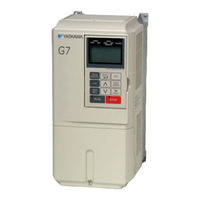
User Manuals: YASKAWA Varispeed G7 Series AC Drive
Manuals and User Guides for YASKAWA Varispeed G7 Series AC Drive. We have 2 YASKAWA Varispeed G7 Series AC Drive manuals available for free PDF download: Instruction Manual
YASKAWA Varispeed G7 Series Instruction Manual (541 pages)
General Purpose Inverter (Advanced Vector Control)
Table of Contents
-
Checks21
-
Wiring37
-
Wiring Check73
-
Checks73
-
Installation75
-
Wiring78
-
Modes88
-
Drive Mode90
-
Verify Mode96
-
Power on101
-
Basic Settings105
-
Autotuning107
-
Load Operation125
-
Loaded Operation125
-
User Constants133
-
Run Command243
-
Stopping Methods245
-
Speed Search298
-
Energy-Saving350
-
Torque Control362
-
Options393
-
Autotuning407
-
Torque Limit407
-
Troubleshooting420
-
Fault Detection421
-
Alarm Detection435
-
Operation Errors440
-
Troubleshooting445
-
Daily Inspection458
-
Specifications481
-
Appendix489
-
Selection494
-
Installation495
-
Settings495
-
Handling496
-
CE Markings501
-
한국 전파법에 관한 주의사항509
-
对应中国 Rohs 指令511
-
本产品中含有有害物质的信息511
-
Wiring Examples512
-
User Constants521
-
Revision History537
Advertisement
YASKAWA Varispeed G7 Series Instruction Manual (499 pages)
GENERAL PURPOSE INVERTER (ADVANCED VECTOR CONTROL)
Table of Contents
-
-
2 Wiring
37-
Wiring Check66
-
Checks66
-
-
-
-
Power on94
-
Autotuning100
-
Loaded Operation107
-
5 User Constants
114 -
-
Run Command216
-
Stopping Methods218
-
-
-
-
-
Message Format301
-
Slave Address301
-
Monitor Data306
-
Enter Command308
-
Error Codes309
-
Energy-Saving321
-
Torque Control333
-
Monitor Function335
-
Fine Adjustments344
-
Options364
-
-
Autotuning378
-
Torque Limit378
-
-
Troubleshooting415
-
Only)424
-
-
-
Daily Inspection428
-
-
9 Specifications
448 -
10 Appendix
457-
-
Selection462
-
Installation463
-
Settings463
-
Handling464
-
-
Wiring Examples476
-
User Constants485
-
Revision History496
Advertisement

